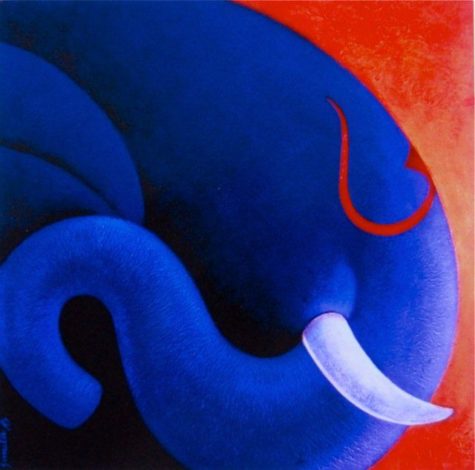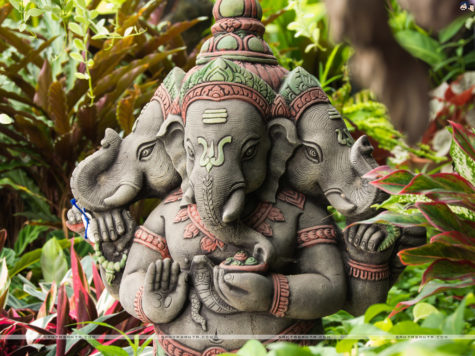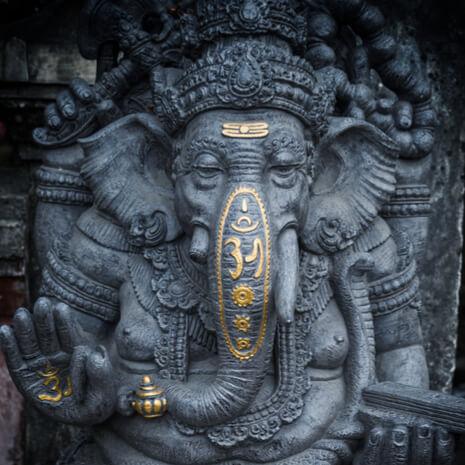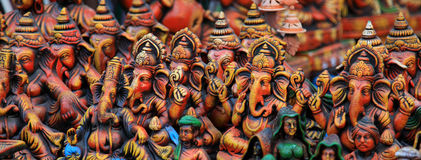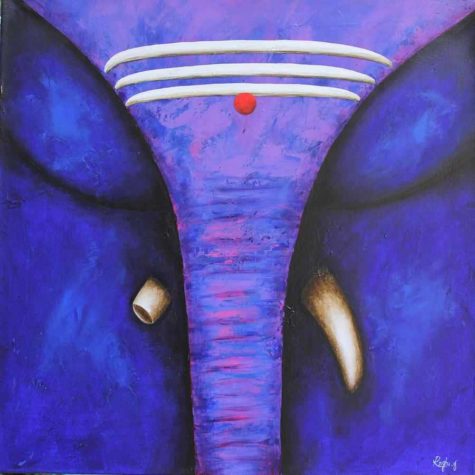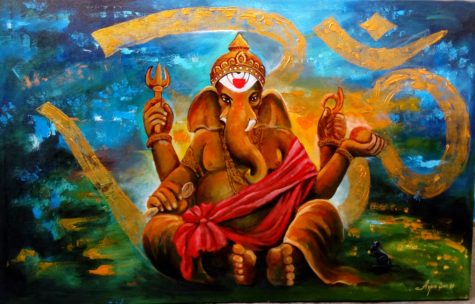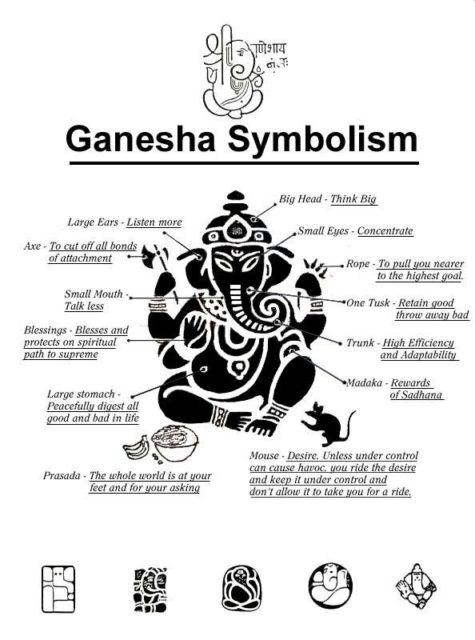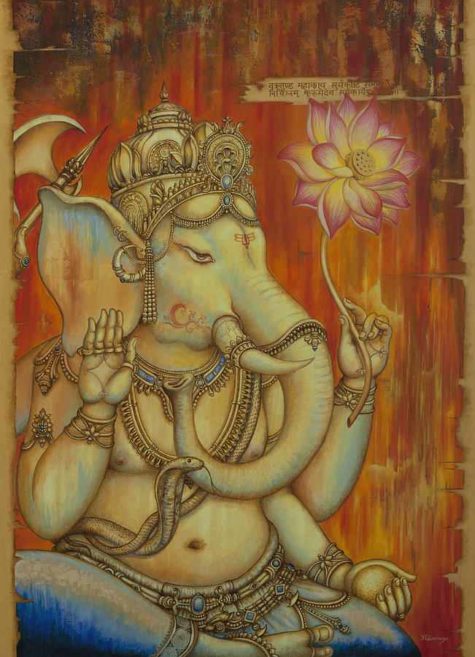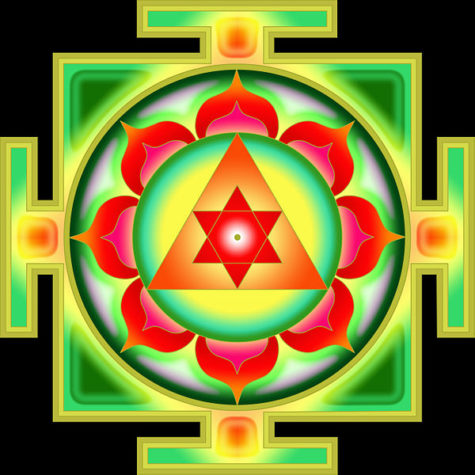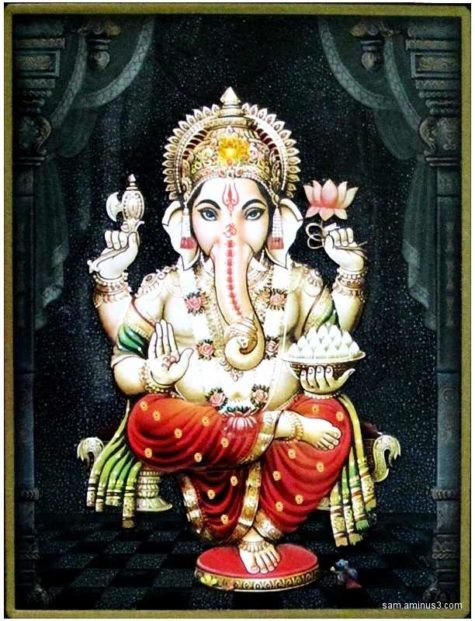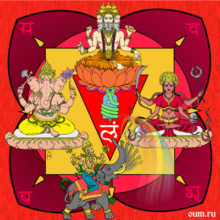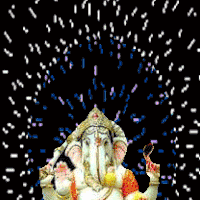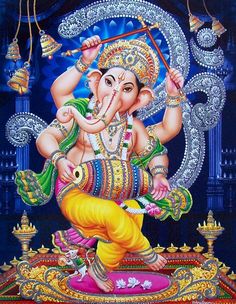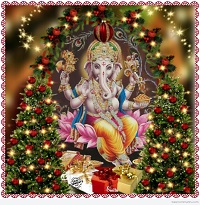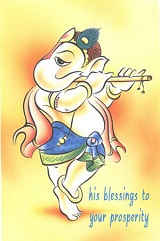Symbolism
Symbolism of the Trunk and Tusk
The trunk is a novel instrument. With its help, Ganesha removes the obstacles from the path of the aspirant. Its orientation towards the left, the right or centre is symbolic in connection with the three principle subtle energetic channels: Ida Nadi, Pingala Nadi and, respectively, Sushumna Nadi. When it is raised to the sky, it signifies the ascension and stability of Kundalini at the level of Sahashrara. In the tantra tradition, the trunk and sensuous mouth of the elephant are connected to the masculine and feminine sexual organs.
The curved trunk also symbolizes the primordial cosmic sound of OM.The well grown trunk of His form represents a well develop intellect and wisdom. Ganesha’s tusk is a symbol of Unity.
Left Side Turned Trunk
In Lord Ganesha, generally trunk is towards his left side accessing a laddu (sweet ball). What does it symbolize? It represents moon and the cool power of ida nadi in our psychic body. This Ganesha helps us to access the fruit of our work in the material world and he also gives the fruits to us very easily with his trunk!
The Lord likes laddus and he gives material comforts (symbolized by laddus) to his devotees. The trunk of Lord Ganesha touches the laddus in the bowl indicates Lords readiness to give the boons using his trunk.
This pose of the left sided trunk in a bowl of laddus is unique form of varada (“boon giving”) gesture of Lord Ganesha. Recall our discussion at the beginning about the trunk of an elephant. Just like in an elephant, Lord Ganesha uses his trunk as a handy tool to either bless us or to give us the boons!
In other words, laddu indicates all material comforts. Since he enjoys the sweet, he will surely bestow them to you too. This why if we need to enjoy material prosperity and comforts, we need to worship and pray Lord Ganesha with left-sided trunk enjoying a sweet laddu! So, Lord Ganesha with left-sided trunk provides us bhoga (material enjoyment).
Right Side Turned Trunk
There is another pose of Lord Ganesha. It is with his trunk turned towards his right side holding a pot of nectar. What is the symbolism here? It represents Sun and the hot power of pingala nadi in our psychic body.The pot of nectar held by right-turned trunk is nothing but the bliss or the happiness obtained in samadhi state in traditional yoga. So, this Ganesha helps us achieve moksha (liberation).
According to Hinduism, the highest purpose of human life is to get liberation from infinite birth and death cycle. So, people who are interested in achieving the real goal of yoga i.e. moksha (or liberation) should pray Lord Ganesha with trunk turned to his right side.
Stories About Ganesha’s Tusk:
There are various anecdotes which explain how Ganesha broke off one of his tusks. Devotees sometimes say that his single tusk indicates his ability to overcome all forms of dualism. In India, an elephant with one tusk is sometimes called a “Ganesh”.
One story of how Ganesha broke his tusk is recounted in this excerpt from the Upodghata Pada of the Brahmanda Purana. Parashurama, the axe-wielding incarnation of Vishnu, had sucessfully defeated his enemy Kartavirya Arjuna and the kings allied with him, and so he wanted to thank Shiva for giving him the power to fight these enemies.
Parashurama went to Mount Kailash to pay his obeisances to Shiva, but Ganesha stopped him, saying his father was sleeping along with his mother, and he didn’t want Parashurama intruding on them in case they might be engaged in amorous pursuits. Parashurama was enraged that he was being prevented from seeing Shiva, and so he started fighting Ganesha. Ganesha was winning handily, but then Parashurama threw his axe at Ganesha and Ganesha didn’t fight back against it, because the axe was a gift from Shiva.
Perceiving that the axe had been given to him by his father, Ganesha became desirous of meaning it not to go in vain. Hence he received it with his left tooth (tusk). Chopped off by the axe, the tusk fell on the ground, covered with blood like a mountain that fell on the ground when struck by Indra’s thunderbolt.
Another story is as follows:
In the first part of the epic poem Mahabharata, it is written that the sage Vyasa (Vyāsa) asked Ganesha to transcribe the poem as he dictated it to him. Ganesha agreed, but only on the condition that Vyasa recite the poem uninterrupted, without pausing. The sage, in his turn, posed the condition that Ganesha would not only have to write, but would have to understand everything that he heard before writing it down. In this way, Vyasa might recuperate a bit from his continuous talking by simply reciting a difficult verse which Ganesha could not understand. The dictation began, but in the rush of writing Ganesha’s feather pen broke. He broke off a tusk and used it as a pen so that the transcription could proceed without interruption, permitting him to keep his word.
Note:
There are other stories about Ganesha losing his tusk, most famously the story included in some manuscripts of the Mahabharata concerning Ganesha breaking his own tusk off to continue writing the Mahabharata as Vyasa was dictating it to him.
Sources:
- Yoga Magazine, issue no. 23
- Rudraksha Yoga
The Symbolic Representation of Ganesha
Ganesha is depicted small in stature, with a large, round abdomen, with four arms and the head of an elephant with a single tusk. In three of his hands he is holds an axe (ankush), a noose (sash) and sometimes a seashell. In some representations, with the fourth hand, he makes a gesture granting his divine favor, but more often he is holding a ladhu, a chickpea cookie. His eyes shine like two precious stones. He is riding or is accompanied by a rat, a former demon which he defeated and then accepted as his vehicle.
This representation may not be very attractive for the rational mind. His animal head and fat body attract children but for those who consider themselves to be adults, he seems ridiculous. It is a mistake however to deceive ourselves by his appearance, because Ganesha is the patron of refined beings who are not deceived by outer appearances. However those who cannot see the Divine in him and are distracted by his representation, become pray for the discursive mind, which represents the greatest obstacle on the spiritual path.
Accepting Ganesha as a Divine Force has the effect of controlling and calming the mind as well as in dissipating doubts. This is why he is considered to be the most suitable deity for removing obstacles. Believing in him generates a huge force, reversing the usual downward flow of energy, orientating it upwards and thus allowing the activation of the superior centers of force in our being. The divine Ganesha is unbreakable. He grants firmness to those who meditate upon him and invoke him at the beginning of all profane or spiritual actions.
In Mugdala Purana it is said: “Ganesha’s human body represents «tvam» (you), the elephant’s head is «tat» (Brahman) and together they signify the unity between these two aspects. Therefore Ganesha’s body is the visible representation of the highest reality, Brahman, expressed by «tat tvam asi» (you are That (Brahman or God)).”
Another explanation is that, generally, Ganesha’s head represents Atman, the Supreme Reality while his body, from the neck down, symbolizes maya, the principle of phenomenal existence. The involvement of Atman in the world is realized through mind and speech.
Article taken from Yoga Magazine magazine, issue no. 23
Ganesha and Science
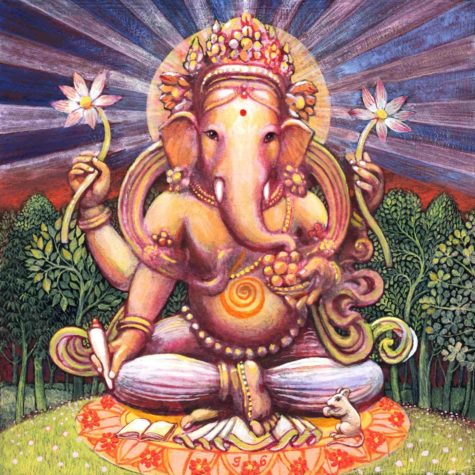
Tradition describes the entire universe as being contained in Lord Ganesha’s big belly. Thus we look upon Him as the overlord who holds sway over the material universe, the sum of cosmic mass. One of His potencies is gravity.
Gravity is a mysterious force to the scientist even today. It is the galactic glue that draws and holds larger mass together and gives order to the macrocosm. It is an instantaneous force, so that when one celestial body moves in a remote corner of a galaxy, all other masses through out the galaxy adjust simultaneously, even though it would take light, at its incredible speed, millions of years to travel the distance.
This implies that space and time are relative concepts and there is “something” that exists everywhere in the universe at once. Like gravity Lord Ganesha is totally predictable and known for orderliness. Without gravity, the known galactic systems could not exist; masses would stray apart; all organization of life as we know it would be impossible. Gravity is the basis of ordered existence in the macrocosm, and our loving Ganesha holds dominion over its mysteries.
Like gravity, Lord Ganesha is always with us, supporting and guiding our physical existence. He is a potent force in the universe, not a representation of potent universal forces. Corpulently built, Lord Ganesha is said to contain within Himself all matter, all mind. He is the very personification of material existence. We look upon this physical world as the body of Lord Ganesha.
In seeing and understanding the varied forces at work in the physical universe, we are seeing and understanding the powers and the being of Lord Ganesha. There is nothing that happens on this material plane of existence except that it is the will of God Shiva and minutely detailed by His beloved son Lord Ganesha. To Him we offer our reverent love and praise.
from Loving Ganesa
by Satguru Sivaya Subramuniyaswami
The Symbolism of Ganesha
Lord Ganesha’s Tools
- Shankha
Conch
Ganesha listens to the puja conch’s loud sound, reminding Him of elephants’ trumpeting happily in the jungle. He summons, “Come one and all to Me and pray.”
- Ankusha
Goad
Loving Ganesha’s deliberate mind prods dullards on in their birth karmas whenever they tarry. with His ankusha He goads forward all souls that are moving too slowly.
- Parashu
Axe
Loving Ganesha knows there are difficult times ahead for some of His devotees. He protects them with His parashu in gentle ways from evils they have attracted.
- Pasha
Noose
Loving Ganesha’s provident mind, like the noose, draws close those He loves most dearly and reaches out to encircle and save strayed ones in extraordinary ways.
- Vajratrishula
Lightning Bolt
Loving Ganesha, like His brother Murugan, wields a sure weapon, the lightning bolt: spirit over mind, mind over matter, ruling both the higher and lower chakras.
- Chakra
Discus
Loving Ganesha holds the discus, symbol of the sun and of the mind, as the moon symbolizes the emotions. Employed as a weapon, it is the intellect divinely empowered.
- Modakapatra
Bowl of Sweets
Loving Ganesha is said to have a sweet tooth, or tusk. But the modaka ball is a symbol of what He loves most, moksha, liberation, the sweetest of all things sweet.
- Gada
Mace
Loving Ganesha is decisive and commanding, as symbolized by gada, His mace. He casts karmas back on devotees for resolution, never letting up until completion.
- Chhuri
Dagger
Loving Ganesha sometimes holds the dagger, keenly sharp, likened to the “razor’s edge,” the narrow and sometimes difficult path the spiritual aspirant must walk.
- Rudraksha Mala
Prayer Beads
Loving Ganesha sits at Lord Siva’s holy feet with japa mala, His prayer beads, in hand, waiting for instruction from the Supreme Lord of all the Gods, His father.
- Pushpashara
Flower Arrow
Loving Ganesha shoots flower-covered arrows from His sugar cane bow in guidance to devotees, so they will not wander too far from dharma’s path of true fulfillment.
- Amritakumbha
Pot of Nectar
Loving Ganesha receives a bath whenever a worshiper knocks his temples with arms crossed. The amrita flows from the sahasrara down to His seat at the muladhara’s base.
- Padma
Lotus
Ganesha wants devotees to learn confidence from the potential of the lotus flower: coming from the depths of the mud into the bud’s opening high above the water.
- Ikshukarmuka
Sugar Cane Bow
Loving Ganesha shows His generous nature of giving all that is good to devotees. His sugar cane bow shoots the kindest arrows, which are projections of His thought.
- Shara
Arrow
Loving Ganesha has power over thought, and each one hits its mark. Bow drawn, arrow aimed, He teaches us to precisely begin all undertakings with good intentions.
- Vina
Indian Lute
Loving Ganesha is sound in all its beauty and meaning. Siva is the ocean; Ganesha is its sound. Siva, the wind God; Ganesha its sound. Listen to the vina within and hear.
- Asura
Goblin
Loving Ganesha is not beyond frightening those who live in the chakra of fear by sending His ganas to lift them into a better life. Sometimes fear is a helpmate in need.
- Danda
Stick
Ganesha carries a short stick, a sign of authority, warning all not to impede the noble ways of dharma and restraining those who have as much as the thought to do so.
- Chamara
Fly-Whisk Fan
Loving Ganesha sits, as He always does, whisking away the past within the minds of devotees, young and old, rich and poor, educated and practical — because He is so wise.
- Kamandalu
Water Vessel
Loving Ganesha, dear to sannyasins, keeps their water vessel full. Symbol of fullness, meeting all needs, kamandalu eternally pours out, never needing to be filled.
- Dhanush
Bow
Loving Ganesha is discreet as He draws His bow and bends His thoughts into forms most helpful to His dear devotees. They all cherish all attentions with great ecstasy.
- Naga
Serpent
Loving Ganesha has a snake as His pet. Many are afraid of such creatures; but He tells us that it is the kundalini within all, and each one can rise above all adversity.
- Shalipallava
Rice Sprig
Loving Ganesha knows rice is the life-sustainer of villagers and city folk alike. Holding a sprig of paddy, He assures rains will come and all will be well at harvest time.
- Mudgara
Hammer
Loving Ganesha wields a mallet, badge of His office as Patron of Arts and Crafts, protector of all who build and shape, chisel and sculpt for the benefit of society.
- Shastra
Scripture
Loving Ganesha studiously edits all the scriptures on this planet and on others, too. His ever-ready, potent pen writes and edits life’s ordinances and comments on their meanings.
- Kalpavriksha
Wish-Fulfilling Tree
Loving Ganesha holds a sprig of the wish-fulfilling tree to tell us that all our wishes will be gratified. We have but to tell Him our needs, that is all, just tell Him.
- Parashvadha
Battleaxe
Loving Ganesha knows sometimes strong measures must be taken to fulfill a righteous goal, like crashing through a jungle. He uses a battleaxe as a mind force.
- Mahaparashu
Large Axe
Loving Ganesha often brandishes a big axe. This powerful weapon frightens off asuras and banishes malicious thoughts of those who intend harm to His devotees.
- Trishula
Trident
Loving Ganesha makes His way through the mind’s vast complexities with His abilities represented by trishula, His three-fold power: Love, Wisdom and Action.
- Narikela
Coconut
Loving Ganesha holds the coconut, symbol of the ego, soft and sweet inside, hard and rough outside. When we break a coconut to Him, we break the ego’s hold on us.
- Dhvaja
Flag
Loving Ganesha is the spirit of mirth. On festival days, the saffron Hindu dhvaja flies proudly over His temples, bringing crowds from near and far.
- Bhagnadanta
Broken Tusk
As the story goes, Ganesha broke off His right tusk in a sacrificial act to use it as a stylus while taking Vyasa’s dictation. Thus he teaches us that we must finish what we start.
- Pashanadarana
Pick Axe
Loving Ganesha is not naive by any means. He knows that trials await devotees, and that He must, in order to respond to prayers, pick, pick, pick away their mental dross.
- Agni
Fire
Loving Ganesha activates His fiery powers, capable of consuming our dross, of destroying our residual karmas, if we but consign our misdeeds to the purifying flames.
- Khadga
Sword
Loving Ganesha has a sword bejeweled with precious gems. It gives notice to those who respond only to fear of His enmity to crime and His abhorrence of hurting.
- Phala
Fruits
Loving Ganesha, dweller in the forest, enjoys all the Earth’s many life-sustaining fruits. He wants parents and children alike to stay healthy by eating lots of energy-giving fruits.
- Mulaka
Radish
Loving Ganesha, by His partiality for the simple radish, makes us grow food that is good for us. He knows devotees may grow more than they need just to please Him.
- Khetaka
Shield
Loving Ganesha holds the shield of divine security, symbol of His power to defend lands of the upright, to preserve traditions and to protect all souls on the spiritual path.
- Amra
Mango
Loving Ganesha says of the mango: “It was given to Me from Lord Siva’s own hand after performing My first wisdom act. It represents the highest spiritual fruition.”
- Tritiyakshi
Third Eye
Loving Ganesha, as do we all, has three eyes, not two, the third being the eye of the mind, of spiritual sight. With this eye He sees the reality behind the world’s seeming.
- Ratnakumbha
Pot of Gems
Loving Ganesha knows the magical power resident in gems. Diamonds, rubies, emeralds are like human souls, each with a different color, faceting, loveliness and value.
- Garitra
Grains
Loving Ganesha knows there are many kinds of people and they need variety in diet. He protects the cultivation of all kinds of grains that make their bodies strong.
- Ikshukanda
Sugar Cane
Loving Ganesha is fond of sugar cane, in fact, of anything sweet. Being the Lord all children adore, it is His joy to see their happy eyes light up when offering sugar cane.
- Madhukumbha
Pot of Honey
Loving Ganesha wears a wide smile across His face when offered a pot of sticky honey. It is, to Him, like moksha itself, the sweetest of all things sweet, worth any effort.
- Kadaliphala
Banana
Loving Ganesha has in His hand the banana, ripe and ready to eat. He looks at it longingly, yet would give it up in a moment should a devotee smell its fragrance.
- Yogadanda
Meditation Staff
Loving Ganesha rests His arm upon a short staff when talking to devotees and when in deep samadhi. He finds it helps Him meditate more effortlessly, more deeply.
- Trina
Grasses
Loving Ganesha knows that there are many kinds of animals, little and big. Each needs a special environment and foods, so He protects the grasses, little flowers and seeds.
- Tila Gola
Sesame Ball
Loving Ganesha teaches us that size may be immense but there is nothing too small to overlook. In His trunk is a sweet made of tiny sesame seeds, and He rides on a tiny mouse.
- Shuka
Parrot
Loving Ganesha delights when the parrot talks and shows he is happy. Perched in Ganesha’s hand, he greets all who come and go, giving his opinion when they are alone.
- Ananasa
Pineapple
Loving Ganesha holds the pineapple and is ready to slice it to share with those in His aura. Giving and sharing is our lesson from the sweet pineapple that He gives us.
- Mushika
Mouse
Ganesha’s companion, a mouse, attests to the all-pervasiveness of the elephant God. Mushika, the mount or vahana, carries Him into the mind’s every nook and cranny.
- Lambodara
Big Belly
Loving Ganesha has this world and all the billions of galaxies in His abundant belly. All known and unknown universes are contained within His prodigious girth.
- Swastika
Mark of Auspiciousness
Loving Ganesha’s good fortunes are represented by the swastika, a sign of luck and auspiciousness. Its crooked arms show how life is filled with change and indirection.
- Jambira
Lime
Loving Ganesha is a practical God, and it is His wish that all who know Him drink the juice from one of His favorite fruits. He wants them to be healthy and enjoy life.
- Aum
Cosmic Sound
Loving Ganesha is Aum. He is the A, the base sound of the universe; He is the U, the sound of the galaxies; and He is the M, the sound of the planets and the littlest stars.
- Shunda
Elephant Trunk
Loving Ganesha has a versatile trunk, and makes it known that it is a symbol of His capacity to always love His devotees. With it He reaches out to touch each of them.
- Nilapadma
Blue Water Lily
Loving Ganesha often sits by a lily pond, pondering the current state of the universe. His province is to see that all is in order until the next Great Dissolution, mahapralaya.
- Panasa Phala
Jackfruit
Loving Ganesha’s favorite, jackfruit, is a potato-like vegetable, a chewy nut and sweet yellow fruit all in one. Like the jack’s stem, our attachments, though small, are strong.
- Prabhavali
Fiery Arch
Loving Ganesha sits within an arch depicting creation, preservation and fiery dissolution. Above is the God of time, Mahakala, who ultimately claims everything.
- Dadima
Pomegranate
Loving Ganesha knows we may be led astray by ways of worldly people who eat meat. He offers us red dadimas, as if saying: “Its many pink seeds are so much better than flesh.”
- Nagapasha
Snake Cord
Loving Ganesha wears a snake around Him to tell us all that we have to be like Him and control our instinctive, animal mind. Yes, it is possible through the grace of this God.
- Kapittha
Wood Apple
Loving Ganesha loves wood apples, kapittha, called the elephant fruit. Sweet to eat, packaged in a tough shell, it is a pharmacy of ayurveda’s secret medicinal potencies.
- Laddu
Milk Sweet
Loving Ganesha was never accused of turning down a laddu, rich with milk, flour and sugar. Maybe it reminds Him of being young. Every young one loves sweets.
- Kavacha
Armor
Loving Ganesha’s sculpted form in temples and shrines worldwide is encased on festival days in silver and gold facsimiles. He likes splendor, pomp and adulation.
- Shashikala
Crescent Moon
Loving Ganesha, like His father, Siva, wears the crescent moon on His great head. It is a symbol of time’s passing, of auspicious moments and of the powers of the mind.
- Gam
Mantra
Loving Ganesha is invoked by devotees through this mystery mantra. Upon hearing it, He immediately responds. Easy of access, He never delays in solving our problems.
- Yajnopavita
Sacred Thread
Loving Ganesha wears across a massive shoulder the holy cord to remind us that we, too, can be twice born through His grace, that none is low and none is high.
- Jambu
Rose Apple
Loving Ganesha loves the rose apple among many other wonderful fruits and vegetables. He shows us the path to good health, harmlessness to creatures and love.
- Payasa
Pudding
Loving Ganesha is seen from time to time enjoying sweet tapioca pudding, likened to the love and kindness that comes from caring for others as one’s very own self.
- Sakti
Consort
Loving Ganesha is often seen with two female consorts, or shaktis. They represent ida and pingala, the two life currents, emotion and intellect, that hold us close to Earth.
- Muladhara Chakra
Base Center
Loving Ganesha, sitting on the four petaled muladhara, rules memory and knowledge as the gatekeeper to the six chakras above and the guard of the seven below.
- Vriksha
Trees
Loving Ganesha is the giver of gifts from healing trees, the practitioner of ayurveda, the great doctor who helps us gain the knowledge of health from medicinal plants.
From Loving Ganesa
by Satguru Sivaya Subramuniyaswami
Yantra of Ganesha
Meditating and focusing upon Ganesha’s yantra grants a state of inner balance.
Its background is vivid green. Green is a blend between warm yellow and cold blue; therefore it is color of balance. Focusing upon it generates its complementary color, red. Red is a color that can be easily noticed from a distance, being the symbol of life and inspiration, of revolutions and of the release from rules and restrictions.
The eight petal lotus stands for the eight aspects of Prakriti (the primordial nature):
- 1. Ether
- 2. Air
- 3. Fire
- 4. Water
- 5. Earth
- 6. Sattva
- 7. Rajas
- 8. Tamas
The six pointed star that is the color of saffron symbolizes the balance between the masculine and feminine energy generated by the overlapping between the masculine triangle with the apex pointed upwards and the feminine triangle with the apex pointed downwards.
The yellow triangle pointed upwards, where the 6 pointed star is depicted, stands for the masculine sap (the vital essence), the elixir of immortality. The color of this triangle is the same as Ganesha’s skin.
Bindu, the point located in the middle of the central triangle represents Ganesha himself. Meditation upon this bindu is the main goal for which the yantra is worshiped. Its color is golden yellow, a color that is appealing and relaxing at the same time.
Article taken from Yoga Magazine magazine, issue no. 23
The 108 Names of Ganesha
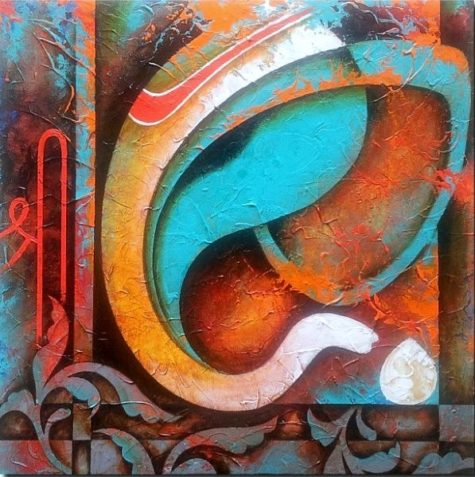
Chanting the 108 names of Lord Ganesha is part of the traditional daily worship called a Puja. It is called the Vighnesvarashtottara Satanamavalihor “garland of Ganesa’s 108 names”. The names are attributes of the Diety, each one delineating an aspect of His infinite and indescribable nature.
Each name is preceded by the mantra Aum (Om) and followed by namah (Namaha) meaning “obeisance, praise, adoration,” or “homage” to.
![]()
Aum Akhuratha Namah
One With Mouse As His Charioteer
Lord Ganesha, with a huge body, has a small mouse as his charioteer. The hugeness matters little when the study of life principles is considered. The soul may be the greatest or the smallest. This represents life in its totality and Lord Ganesha is suggestive of these cosmic aspects.
![]()
Aum Alampata Namah
The Eternal
By whose puissance this world of illusion is manifest, whose creation is this universe, who is the Lord of all gods and creation, he is the Eternal, Lord Ganesha.
![]()
Aum Amit Namah
One Who Has No Comparison
Ganesha is the embodiment of ‘OM’, the symbol of the Great God. He is the Eternal Spirit, the Beginning of all beginnings, beyond comparison.
![]()
Aum Anantachidrupamayam Namah
Infinite And Consciousness Personified
He who is the root cause of the worlds, who is uniquely manifest in the hearts of all, can be realized only by concentrated meditation. Lord Ganesha, the Infinite, is beyond distinctions and beginning.
![]()
Aum Avaneesh Namah
Master Of The Whole Earth
As a rotund, elephant-faced figure, Lord Ganesha is the Lord and Master of the whole earth.He is the protector of the visible world and leader of the helpless, destroying all evil and obstacles.
![]()
Aum Avighna Namah
Without Obstacles
The mighty, massive Ganesha, mounted on his vehicle, bestows everything desired if his devotees chant his name with fervor and devotion; He is also responsible in keeping away all obstacles from their path.
![]()
Aum Balaganapati Namah
The Beloved Child
Lord Ganesha is adored by all the gods, even by the four-faced Brahma, and Lord Indra. As the elephant-faced child, he is the color of the rays of the rising sun.
![]()
Aum Bhalchandra Namah
Sporting The Moon Crest
A moon crest adorns the forehead of Lord Ganesha. It denotes a pot of nectar, providing divine coolness to the wearer. It also denotes intelligence and mental, enlightenment, the moon being the symbol of mind and peace.
![]()
Aum Bheema Namah
Gigantic
The massive Lord Ganesha reposes on the jeweled throne with the snare, the hamulus and the lotus flower in his hands. On his forehead reposes the moon. He is four-armed, has a single tusk, a trunk askew, a potbelly and he is gigantic.
![]()
Aum Bhoopati Namah
Lord Of The Lords
Bhoopati, also called Ganapati, is the Lord of the lords, the Master of the ganas or celestial hordes. He is worshiped by Brahma himself and is worshiped in all the three worlds.
![]()
Aum Bhoovanpati Namah
Lord Of The Lords
Bhoovanpati is the Great God Himself to whom even the Trinity – Vishnu the Protector, Shiva the Destroyer and Brahma the Creator – pay obeisance and propitiate Him to save the world from evil.
![]()
Aum Buddhinath Namah
Lord Of Wisdom
Lord Ganesha, the Lord of wisdom is the repository of all knowledge. His illimitable erudition makes even Goddess Saraswati and Sage Narada bow their heads in awe.
![]()
Aum Buddhipriya Namah
Bestower Of Knowledge
Buddhipriya, the repository of knowledge, bestows guileless discretion to the worshiper. As ruler of the Mooladhara Chakra or plexus, he arouses a person’s latent energy or life force to take him to the Divine Light.
![]()
Aum Buddhividhata Namah
God Of Wisdom
By chanting Lord Ganesha’s name day in and day out, one gets richer by imbibing all knowledge and wisdom from him, who is of enlightened heart and unwavering wisdom.
![]()
Aum Chaturbhujeti Namah
Four-Armed
The four-armed Ganesha is an embodiment of truth, discretion, having control over money power and bondage. These four arms represent the four castes: Brahmin, Kshatriya, Vaishya and Shudra, symbolically indicating his divinity.
![]()
Aum Devadeva Namah
Lord of All Lords
Lord Ganesha is the Master of all. He is always worshiped in the three worlds by all, and is the first to be reverenced among the celestials.
![]()
Aum Devantakanashakarin Namah
Destroyer Of Demons
Lord Ganesha, the Destroyer of evils slew the powerful demons, re-establishing righteousness and peace in the three worlds.
![]()
Aum Devavrata Namah
Accepter of All Penances
The elephant-faced Ganesha is propitiated by all as He is Auspiciousness personified. He is the granter of boons and -responds to penances of his devotees.
![]()
Aum Devendrashika Namah
Protector Of the Gods
Lord Ganesha, Protector of the gods is their beloved. With a large form, who has the mouse as his vehicle, he is the embodiment of peace and tranquility-the giver of peace to all.
![]()
Aum Dharmik Namah
One Who Favors Charity
The Great Lord Ganesha is gentle, forgiving and compassionate. He likes to prod man with his goad to the path of righteousness and truth so that he can learn to be charitable.
![]()
Aum Dhoomravarna Namah
Smoke-Colored Body
The smoke-hued Ganesha is the beloved Lord of gods and mortals. His body is sometimes compared with a red lotus. His hands are ornamented with gem-studded bangles and his whole smoke-colored image is enchanting.
![]()
Aum Durja Namah
The Invincible
Ganesha, the elephant-faced, pot-bellied Lord is Infinite Strength and Power personified. He is deathless, has no beginning or end – he is invincible.
![]()
Aum Dvaimatura Namah
Son Of Two Mothers
Goddess Parvati created~ a child from the perspiration that came off her body. She lowered him into the River Ganga and he grew into a large being. Both Parvati and Ganga claimed to be his mother.
![]()
Aum Ekaakshara Namah
Of The Single Syllable
Lord Ganesha is the symbol of a single syllable ‘OM’, the symbol of the Great God. He is also known as Pranava, the sound from which the world emanated.
![]()
Aum Ekadanta Namah
He Of Single Tusk
The rotund, massive Ganesha sports a single tusk, a broken one, which symbolizes him as beyond the rules of cosmic orderliness, as he is the cosmos itself. The broken tusk represents the shedding of the ego.
![]()
Aum Ekadrishta Namah
Single-Tusked
The single-tusked Ganesha stands for one direction. He gathers information from various directions, but having decided his course of direction, he does not waver. The single tusk represents the non-dualistic nature of reality.
![]()
Aum Eshanputra Namah
Son Of Shiva
Lord Ganesha is the elder son of Lord Shiva and Parvati. He is the elephant-faced son, having a simple broken tusk and a trunk that is askew. He is the delight of them.
![]()
Aum Gadadhara Namah
Wielder Of The Mace
As Gadadhara, Lord Ganesha wields powerful weapons for destroying demons of evil. The gada or Mace is the divine weapon used to wipe out evil and slay the asuras.
![]()
Aum Gajakarna Namah
Elephant-Eyed
The elephant-eyed Ganesha is the embodiment of goodness and virtue, his size belying his non-violent nature. The small eyes radiate wisdom and compassion, powerful, yet gentle.
![]()
Aum Gajanana Namah
Elephant-Faced
Lord Ganesha in the form of Gajanana, with an elephant face, is deemed to be a very auspicious symbol, warding off possible mishaps and troubles. He stands for power and strength.
![]()
Aum Gajananeti Namah
Elephant-Faced
The elephant-faced Lord Ganesha is one-tusked, has a large, body with a huge belly, and is capable of destroying all obstacles.
![]()
Aum Gajavakra Namah
Elephant Trunk
Ganesha with his twisted trunk is symbolic of his vast knowledge and powers of discrimination, vital for spiritual progress. The curved trunk is shaped like ‘OM’ also symbolic of the life force energy.
![]()
Aum GajavaktraNamah
Elephant-Mouthed
The elephant-mouthed Ganesha is very fond of sweets. With a huge belly signifying wealth and the modaka sweet in his hand, symbolic of the sweetness of the realized Inner Self, he personifies love.
![]()
Ganadhakshya
Lord Of The Celestial Hordes
Lord Ganesha is the Chief of the group of gods, the. celestials. He is the first to be worshiped by the gods and mortals alike. He is the Lord of all he surveys, the Master of the earth, the universe, the cosmos, all creation.
![]()
Aum Ganadhyakshina Namah
Lord Of The Celestials
Lord Ganesha is the Lord of the gods and is the beloved of all. As the Chief and Supreme God among gods, he is worshiped by all.
![]()
Aum Ganapati Namah
Lord Of The Ganas
Lord Ganesha is also called Ganapati, the Lord of the celestial hordes. He is the Supreme Deity, Lord Almighty, who rules over the entire kingdom of the gods.
![]()
Aum Gaurisuta Namah
Son Of Gauri
Gauri is another name of Goddess Parvati. Gaurisuta is Lord Ganesha, the deft son of Gauri. He enlightens and causes his mother’s face to blossom with his love and devotion.
![]()
Aum Gunina Namah
Lord Of All Virtues
Gunina, the Lord of all virtues, is Grace personified, making everything auspicious. His immense grace and radiance is supreme and ethereal, and is adored by one and all.
![]()
Aum Haridra Namah
The Golden One
Lord Ganesha, although smoke-colored, is the Golden One, as he has a moon crest on his forehead, a sacred thread in the form of a serpent round his body, cheeks anointed with a vermilion paste, glowing golden like the rays of the sun.
![]()
Aum Heramba Namah
Beloved Of The Mother
Lord Ganesha is Heramba, the fire-headed Protector of the weak. He is his mother’s beloved, and is her protector.
![]()
Aum Kapil Namah
Tawny-Coloured
The tawny-coloured elephant-faced Ganesha is the God of wisdom who teaches that the path of success and achievement is through the use of intellect, and that through wisdom alone can one reach salvation.
![]()
Aum Kaveesha Namah
Lord Of Poets
Ganesha is the Lord of wisdom from whom emanates knowledge that is divine. All poets invoke his grace before picking up their pens, for he is the Lord of poets from whose divine pen flow divine words.
![]()
Aum Kirti Namah
Lover Of Music
Lord Ganesha is Nada Brahman, Lord of music. He is the repository of knowledge and a mine of virtues from whom emanates illimitable erudition, and cosmic music and rhythm.
![]()
Aum Kripakaram Namah
Who Is Merciful
Lord Ganesha, as Kripakaram, wavy with profound kindness, is the sea exhibited by his eyes. He is ever Merciful and the beacon of divine fight.
![]()
Aum Krishapingaksha Namah
Black- Yellowish -Brown -Eyed
Lord Ganesha, whose, eyes radiate power, compassion, wisdom and love, is omnipotent and infinite. His small eyes dazzle with the exuberance of the fight of a million suns, entire kingdom of the gods.
![]()
Aum Kshamakaram Namah
Abode Of Forgiveness
Constant and regular chanting of Lord Ganesha’s name is a sure path for atonement of sins. He is the abode of forgiveness, the seat of compassion, and most forgiving. Repose faith in him and he will protect you.
![]()
Aum Kshipra Namah
Quick-Acting
Handsome of appearance and red in color like the hibiscus flower, he holds his broken tusk, noose, goad, and sprig of the wish-fulfilling tree in his, hands and a pot of precious gems in his trunk.
![]()
Aum Lambakarna Namah
Large-Eared
The large-eared Ganesha is a mine of information gathered from all directions. His large ears are used for winnowing information, retaining only the essentials.
![]()
Aum Lambodara Namah
Huge-Bellied
The big-bellied Ganesha is the symbol of the whole universe-all that is conceivable in the whole cosmos- from which all events of the world emerge. It is symbolic of his capacity to assimilate the whole information.
![]()
Aum Mahabala Namah
Extremely Strong
Lord Ganesha, with his huge body, is symbolic of the cosmos or the universe. He is extremely strong and powerful, endowed with intellectual prowess.
![]()
Aum Mahaganapati Namah
The Omnipotent And All-Powerful
Lord Ganesha, the Almighty, the Supreme Infinite, is omnipotent and all powerful. His infinite form is beyond man’s comprehension, and is limitless.
![]()
Aum Maheshwaram Namah
Lord Of The Universe
Maheshwaram, from whom the universe is born, is the Eternal Brahman. All the elements-earth, fire, air, water and ether-are manifest in him. He is the Supreme Lord of the universe.
![]()
Aum Mangalamoorti Namah
The Auspicious
Lord Ganesha is the personification of all that is auspicious. He who was worshiped by Lord Shiva before his vanquishing Tripurasur, by Lord Vishnu before his tying of Bali in the rope, by Lord Brahma before creating the world, by Parvati before her slaying the demon Manisha, is Mangalamoorti.
![]()
Aum Manomay Namah
Conqueror Of One’s Heart
Lord Ganesha is the God of all people, big and small, educated and illiterate. He is compassionate and forgiving, wise and intellectual. With his huge body, gentle eyes and calm countenance, he fills one’s heart with love.
![]()
Aum Mritunjaya Namah
Deathless
The Infinite Lord Ganesha has no beginning or end. He is deathless and the root cause of the creation. He is the embodiment of ‘OM’, the symbol of the Great God who has no end and is invincible.
![]()
Aum Mudakaram Namah
Abode Of Joy
Lord Ganesha is the home of Siddhi and Buddhi, the repository of knowledge and the abode of joy. He bestows happiness and welfare to all.
![]()
Aum Muktidaya Namah
Giver Of Eternal Peace
Muktidaya is Lord Ganesha who grants security to his devotees, thereby providing eternal peace. He destroys all the obstacles that one may face when entreated by his devotees.
![]()
Aum Musikvahan Namah
He With The Mouse As His Vehicle
Lord Ganesha, with I his massive body, favors the Mouse as his beloved vehicle. The mouse, known to cause great havoc, is kept under the control of Ganesha by serving as his vehicle.
![]()
Aum Nadapratithista Namah
Lover Of Music
Lord Ganesha is symbolic of the music and rhythm of the cosmos. He loves music and sometimes a veena is one of the attributes seen in his hands. He is the patron of music and dance.
![]()
Aum Namasthetu Namah
Destroyer Of All Sins
Lord Ganesha is the sea-fire to end the sea. He purges the devotees of all sins by incinerating the sins and impieties by his holy fire.
![]()
Aum Nandana Namah
Son Of Lord Shiva
Nandana, son of Lord Shiva, is the mind-born son of Lord Shiva, or, as popularly believed, the creation of Parvati. He is the elder son of Shankara, and the beloved of his mother, Uma.
![]()
Aum Nideeswaram Namah
Master Of All Kinds Of Treasures
Lord Ganesha, the repository of knowledge, is adorable, with his plump body, his tusk broken and single. His is the Lord of all wealth-material as well as spiritual-endowed with intrinsic qualities that command the respect of all.
![]()
Aum Pashin Namah
One Who Sits Like A Rock
Lord Ganesha is Infinite and Consciousness personified, solid and unwavering like a rock, who is unshakable, invincible, the seat of infinite power, the pure essence of luminous mind.
![]()
Aum Pitambar Namah
Wearer Of Yellow Clothes
Lord Ganesha, who wears clothes of white and yellow, personifies purity and uniqueness. With a deep knowledge of the self, he is the eternal spirit who is changeless yet causes change all around.
![]()
Aum Pramod Namah
Lord Of The Place
As Pramod, Lord Ganesha is the only refuge of the shelterless as he is Lord of the place. He is the Lord of the gods, the repository of wisdom, the seat of spiritual awakening, from whom creation has come.
![]()
Aum Prathameshvar Namah
One Who Holds The First Place
Lord Ganesha, the eternal spirit, the Brahman, is the God of Auspiciousness, holding the first place. He is the Beginning of all beginnings, worshiped by Mahesha and other gods.
![]()
Aum Purush Namah
The Supreme Authority
Lord Ganesh is Punish, the Supreme Authority. He is the Omniscient Lord Almighty who rules over the entire universe. He is the Ultimate Reality, the One Truth, the Manifest Spirit.
![]()
Aum Rakta Namah
Red-coloured
Lord Ganesha’s body hue is compared to the red lotus and his tusk to the vermilion blood marks when it is thrust into his enemies for destruction.
![]()
Aum Rudrapriya Namah
Beloved Of Shiva
Lord Ganesha, the beloved son of Shiva, is the Master of all, whose virtuous qualities are orisoned by even the creator, Brahma. He is Shiva’s revered and noble son.
![]()
Aum Sarvadevatman Namah
Accepter Of Celestial Offerings
As Lord of the gods, Lord Ganesha is happy to accept the loving offerings of the celestials. They adore and worship him, and as their Master, and he bestows his grace on them.
![]()
Aum Sarvasiddhanta Namah
Provider of Adeptness To His Disciples
The repository of wisdom and knowledge, Lord Ganesha bestows success on his devotees. He who chants his name continually will be sure of being blessed with the ability to be adept in all his actions.
![]()
Aum Sarvatman Namah
Blesser Of The Universe
He who dwells in every heart in a secret manner, by whose command this entire world exists, who is Infinite and the Enlightener of the hearts, by knowledge, he is Sarvatman, Lord Ganesha.
![]()
Aum Shambhavi Namah
Son Of Parvati
Lord Ganesha is the son of Lord Shankar and Goddess Parvati. He is the playfully deft son and is adored by his parents. He enlightens and causes his mother’s face to blossom with love for him.
![]()
Aum Shashivarnam Namah
Moon – Complexioned
He who is attired in a white garment and who is all pervading, is Lord Ganesha, the elephant-faced Lord with a moon-complexion that glows brightly, indicating mental enlightenment, the moon being the symbol of peace.
![]()
Aum Shoorpakarnai Namah
Large-Eared
Lord Ganesha is the Lord with large ears. These large ears serve the purpose of gathering information from all possible directions. Like a winnowing basket, His ears are receptive and attuned to every mortal’s cry of woe or praise.
![]()
Aum Shuban Namah
One Who Is Auspicious
A prayer to Lord Ganesha precedes all worship for he is auspicious and nothing can take place without invoking his name. For, he is the remover of obstacles in one’s path, and the guarantor of success in. all ventures.
![]()
Aum Shubhagunakanan Namah
Mine Of All Virtues
Lord Ganesha is the Lord of all treasures and virtues; symbolic of perfection and infinite beauty he is compassionate, forgiving, endearing and protector of all that is good.
![]()
Aum Shweta Namah
White Color
The huge-bellied Lord Ganesha, with an elephant face, a single-tusk which is askew, has his body and clothes white, being worshiped on the shore of ocean of milk with white flowers. His face beams the beatitude.
![]()
Aum Siddhidhata Namah
Bestower Of Success
The chanting of Lord Ganesha’s name will pay rich dividends in the form of being bestowed with success. The Lord is the bestower of the desired abilities.
![]()
Aum Siddhipriya Namah
Bestower Of Boons
Siddhipriya is Lord Ganesha who grants the desires and boons of his devotees. Being compassionate and large-hearted the elephant-faced Ganesha fulfills the wishes of worshipers.
![]()
Aum Siddhivinayaka Namah
Bestower Of Success
Lord Ganesha’s huge pot-belly is symbolic of wealth and success. He bestows both on his devotees, being the kind and compassionate Lord who grants them boons and showers them with success.
![]()
Aum Skandapoorvaja Namah
Older Than Skanda
Ganesha is the older son of Shiva and Parvati, and brother of Skanda (Karthik). He is the destroyer of the asura’s pride, and protector of the weak and helpless. He protects and loves his brother Skanda.
![]()
Aum Sumukha Namah
Of Auspicious And Pleasant Visage
His strange visage is in the form of ‘OM’, the sound symbolic of the cosmic reality. Ganesha, with the bulky body, stands for the cosmos in its entirety. He is the symbol of auspiciousness.
![]()
Aum Sureshwaram Namah
Lord Of All The Gods
Sureshwaram is Lord Ganesha as Head of the ganas or celestials. He is the Supreme Being, the Foremost Being, the very cause of the creation of the cosmos Lord Almighty.
![]()
Aum Swaroop Namah
Lover Of Beauty
Lord Ganesha, the Master of resourcefulness and perfection in all spheres, is a lover of beauty. His awkward body signifies that outward form has no connection with inner beauty and spiritual perfection.
![]()
Aum Tarun Namah
The Youthful
The young Ganesha, ever youthful, is Wisdom personified. His huge body takes on the color of red like the noonday sun, depicting the strength of, youth.
![]()
Aum Uddanda Namah
Punisher Of Evil
Uddanda is Lord Ganesha as punisher of evil. He also forgives those who seek his pardon. He is the vanquisher of demons and remover of all obstacles.
![]()
Aum Umaputra Namah
Son Of Uma
Uma, another name of Parvati, desired to have a son. Lord Shiva granted her wish and Ganesha took form. He is the beloved son of Uma, her delight, and obedient servant, ever ready to serve her.
![]()
Aum Vakratunda Namah
Askew-Trunked
Lord Ganesha, the single-tusked one, is attributed with an askew proboscis or trunk, which symbolizes power, capable of destroying all obstacles and evil.
![]()
Aum Varaganapati Namah
Bestower Of Boons
Ganesha is the bestower of all fruits of desire and granter of all adeptness that his worshipers seek. He is magnanimous and forgiving, being a wealth of knowledge and wisdom.
![]()
Aum Varaprada Namah
Granter Of Boons
Lord Ganesha grants boons to his devotees. He is most efficacious. He gives knowledge to the seeker of wisdom, prosperity to those desiring wealth, issues to the childless, and guidance to the attainment of spiritual liberation.
![]()
Aum Varadavinayaka Namah
Bestower Of Bounty And Success
The massive Ganesha, the granter of boons to his devotees, is the guarantor of success in all ventures. His devotees need never fear failure. As the benefactor of his devotees, he is greatly adored by them.
![]()
Aum Veeraganapati Namah
The Valiant Warrior
The red-complexioned Ganesha is sometimes attributed with eight pairs of arms, holding a bow, arrow, goblin, spear, hammer, mace, pick-axe, serpent, banner, trident, discus, goad, noose, battleaxe, sword and shield – all signs of a valiant warrior.
![]()
Aum Vidyavaridhi Namah
Repository Of All Knowledge
Lord Ganesha is the God of wisdom. He incinerates ignorance by his divine fire and enlightens by his knowledge. He is a gold mine of knowledge and wisdom.
![]()
Aum Vignahara Namah
Destroyer Of Evil
Vignahara is Lord Ganesha, who, like a vigorous wind, scatters away and destroys the dark clouds of evil. His name’s mere recollection removes all sins.
![]()
Aum Vignaharta Namah
Destroyer Of Obstacles
Lord Ganesha is a veritable sceptre that destroys all obstacles. He is the destroyer of multitudes of obstacles, destroyer of all afflictions.
![]()
Aum Vighnanashin Namah
Destroyer Of Obstacles
The askew-trunked Ganesha, also called Vighnanashin, is the destroyer of all impediments. He is the destroyer of darkness created by obstacles.
![]()
Aum Vighnaraja Namah
Lord Of All Obstacles
The veritable sceptre to destroy all objects, Lord Ganesha is invincible. He is the inimitable jungle fire who destroys the jungle of troubles for his devotees. He is the destroyer of multitudes of obstacles.
![]()
Aum Vighnarajendra Namah
Lord Of All Obstacles
The noble Ganesha is the King of all the factors causing obstacles. He causes obstacles for the demons and enemies, causing them to stumble and be vanquished.
![]()
Aum Vighnavinashanaya Namah
Destroyer Of All Afflictions
The four-armed Ganesha is sometimes attributed with eight pairs of hands that are symbolic of destruction of evil. He protects his devotees by destroying all afflictions.
![]()
Aum Vigneshwar Namah
Lord Of All Obstacles
Vigneshwar, the only sun to destroy the darkness caused by obstacles, the only fire to incinerate the jungle of impediments, the only Garuda to browbeat the haughty snakes of troubles, is the Lord of all obstacles.
![]()
Aum Vikat Namah
Of The Monstrous Figure
Lord Ganesha, the most adorable one, adored by all gods, is endowed with a huge, monstrous body, symbolizing unity of the primeval forest denizen with man – combining the physical energies of mortals.
![]()
Aum Vinayaka Namah
Lord Of All
As Vinayaka, Lord Ganesha is the Supreme Leader of all, being endowed with special qualities. He is the Chief of all the celestial demi-gods, and is ever adored by them.
![]()
Aum Vishwamukha Namah
Lord Of The Universe
Lord Ganesha is the Supreme Reality, the Atman of all. He is the witness of all that is happening in the world. He is the Lord of the universe, the Supreme Being who has no beginning, who has no end.
![]()
Aum Yagnakaya Namah
Accepter of Sacrificial Fires
The calm and majestic Ganesha, with the strength and power of an elephant, is the Lord of the universe. He evokes great love and accepts the sacrificial fires offered to him by gods and mortals.
![]()
Aum Yashaskaram Namah
Giver Of Fame And Glory
Lord Ganesha is worshiped by both the devas and the asuras, for he is the Lord of the gods. He gives prosperity, fame and glory to-all the worlds, shining with a lustrous glow.
![]()
Aum Yashvasin Namah
The Popular
The pot-bellied, askew-trunked single-tusk Ganesha is popularly the beloved of all. He is the subject of those who sing his praise, the jewel from whose face flows nectar.
![]()
Aum Yogadhipa Namah
Lover Of Meditation
Lord Ganesha is the fountainhead of wisdom, the Great God ‘ that Eternal Truth, that Eternal Reality. His name is chanted at the beginning and end of meditation at all times.
The Significance of Ganesha
The Divine Mother assumes infinite names and forms, each of which expresses a different facet of Her being. The deity Ganesha, Her first-born son, is a case in point. Ganesh is a compound of the Sanskrit words gana and isha. Gana means “individual beings, independent units, segments of light, discrete bodies of Divinity, unique forces, emanations of Divine Light, attendants of the main deity.” Isha. means “one who is capable of doing what he wishes, capable of refraining from what he does not wish to do, and capable of undoing that which has already been done” – in short, the Almighty Lord.
Ganesha dwells eternally in the womb of the Divine Mother. He is the “firstborn one,” emerging from Her before any of the functioning forces of the universe emerge. In their manifest form all these forces center around this primordial force – Ganesha is the locus for all that exists. He establishes law and brings order out of chaos, causing the universal forces to function coherently.
The first step in bringing order out of chaos is the emergence of the law of gravity, and Ganesha is the presiding deity of that law. At his behest the force of gravity captures all the matter and energy emitted by the primordial Divine Force and gives direction to its outward movement. Ganesha himself is the center of all gravitational energy, and as such he supervises all activities, from the microcosm to the macrocosm-everything in the universe is held by the invisible strings of gravity, while gravity itself is held by Ganesha. The forces of creation, maintenance, and destruction are held in harmonious balance by his will, and that is why this firstborn child of the Divine Mother is called “Ganesha,” the lord of all entities and functioning forces of the universe.
According to the chakra scheme of kundalini yoga, Ganesha resides in the first chakra, the muladhara. Mula means “original, main”; adhara means “base, foundation.” From the standpoint of manifestation, or outward expansion of the primordial Divine Force, the muladhara chakra is the principle on which everything rests. In his visual form at the muladhara center, Ganesha is described as an enormous man with the head of an elephant. He is heavy and strong, capable of crushing obstacles into dust. Seated at the base of the spine he holds, supports, and guides all other chakras, thus governing the forces that propel the wheel of life.
To understand the symbolic meaning of Ganesha’s personality we have to examine his personified form. Half human and half elephant, he represents human intelligence wedded to the strength of an elephant. The parts of his body are disproportionate: he has big ears, small eyes, a long trunk,a massive belly, and small feet. He is paradox embodied: although he is enormous, his vehicle is a mouse; he consumes huge quantities of food, yet he is an ascetic; he is fat and his legs are short, yet he is master of the dance.
His boundless intelligence is symbolized by his big head.The epithet given to him in both Vedic and tantric scriptures is Brahmanaspati, “lord of knowledge and intelligence” or “lord of pervasiveness.” The scriptures also refer to him as Jyeshtha Raja, “the eldest son,” even though he was never born.
Ganesha’s massive belly symbolizes his capacity to consume and contain the universe that evolves from the Divine Mother. As the lord of gravitational energy he has the capacity to pull anything toward himself and process it as he wishes. He also sets the wheel of karma in motion. That is why the scriptures describe him as Karma Adhyaksha, “the one who presides over karmic law.”
Ganesha is immortal. In him lies the seed of omniscience,and the most subtle mysteries of the universe are known to him, including the mysteries related to our mind, karma, and the cycle of birth and death. The rays of light emanating from him enable us to comprehend our deeply rooted karmic impressions and discover how to attain freedom from the binding forces of our mind. Only then are the obstacles emerging from its unlit corners fully destroyed. Hence he is called Vighnesha, “the lord who removes obstacles.”
Like fire,Ganesha consumes anything in his path with his enormous appetite. He is pleased with any offering we make to him with love – he gladly accepts our problems and concerns and swallows them, granting us freedom once and for all. No force other than Ganesha is capable of consuming our ignorance, egoism, attachment, aversion, and fear of death.That is also why he is called Vighnesha, “the lord who removes obstacles.”
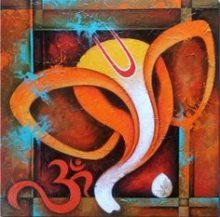 His big ears symbolize his limitless capacity for hearing.He hears our prayers regardless of how we recite them – he does not care whether or not we sing hymns in his praise, he considers our heartbeat and brainwaves to be forms of prayer.Any irregularity, whatever the cause, catches his attention.Being Ganesha, the head of the family, he rushes to our rescue.For these reasons, too, he is known as Vighnesha, “the lord who removes obstacles.”
His big ears symbolize his limitless capacity for hearing.He hears our prayers regardless of how we recite them – he does not care whether or not we sing hymns in his praise, he considers our heartbeat and brainwaves to be forms of prayer.Any irregularity, whatever the cause, catches his attention.Being Ganesha, the head of the family, he rushes to our rescue.For these reasons, too, he is known as Vighnesha, “the lord who removes obstacles.”
The fluid that sometimes flows from the temporal gland of male elephants flows constantly from Ganesha, and drawn by its sweet aroma insects drink the nectar. Intoxicated, they buzz around his ears, which he flaps gently in order to ward them off. This tells us metaphorically that Ganesha’s head, the treasure-house of wisdom, is so filled with the sweetness of love and compassion that it flows from him effortlessly and incessantly and is granted even to those who come to him with a noisy mind.
Set in his enormous head, Ganesha’s eyes are small because he has little use for them. However his third eye, the eye of intuition, is wide open, and he sees past, present, and future simultaneously. Seated as he is deep within every living and non-living entity, he sees everything. That is why he is called Adi Rishi, “the primordial seer.” He is the eternal source of knowledge – revelation flows through him. The scriptures refer to him as Parama Guru, “the master of all previous masters.”
The scriptures identify Ganesha with the sacred sound Om, and the shape of his trunk resembles the word written in Sanskrit. Because Om is the source of all mantras, repeating any mantra is tantamount to meditating on Ganesha.All sounds, words, and mantras in their dormant form rest in the muladhara chakra, where Ganesha resides.
The most subtle, vibrationless state of sound in the muladhara chakra is called “para.” At the behest of Ganesha,who presides over gravitational energy, a stirring arises in the muladhara chakra that can be detected only intuitively. This vibrationless vibration can be felt when it reaches the navel center; when it reaches the heart center, it assimilates the power of thinking; and it becomes audible when it reaches the throat center. Ganesha oversees this entire process. Without his assistance and guidance we can neither gain access to the muladhara center nor receive the ensuing revelation.That is why Ganesha is said to be the gatekeeper at the palace of the Divine Mother.
Though Ganesha’s feet are quite small, he outruns all the forces of the universe – because he pervades everything, he is already everywhere. Without moving, the lord of gravitational energy makes everything move. With his enormous body and tiny feet Ganesha dances to the song of the Divine Mother, and exhilarated by his movements, She joins in.Then, as mother and son perform their cosmic dance, all the arts and sciences spring forth. Unable to contain the divine ecstasy, the sages emerge from their absorption in Ganesha and assume their roles as our guides.
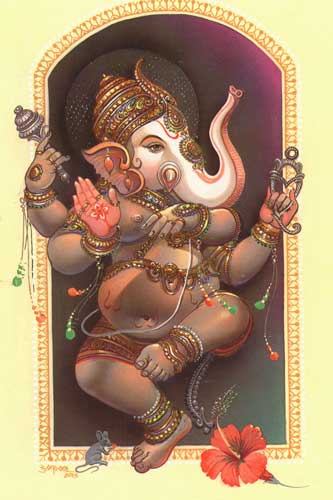 This cosmic dance symbolizes the process of kundalini awakening. The forces of darkness can cast their spell of slumber on us only as long as we are outside the pale of this dance. Thus Ganesha, the remover of obstacles, is the one who awakens the divine force in the form of kundalini shakti. He blesses us with shaktipata (the bestowing of divine energy). It is he who sends a sat guru (a true master) into our lives, and through his grace the forces of love, compassion, self-motivation, self-confidence, and determination unfold. Thus the scriptures assert that the door to the Divine Mother’s palace opens when Ganesha is pleased.
This cosmic dance symbolizes the process of kundalini awakening. The forces of darkness can cast their spell of slumber on us only as long as we are outside the pale of this dance. Thus Ganesha, the remover of obstacles, is the one who awakens the divine force in the form of kundalini shakti. He blesses us with shaktipata (the bestowing of divine energy). It is he who sends a sat guru (a true master) into our lives, and through his grace the forces of love, compassion, self-motivation, self-confidence, and determination unfold. Thus the scriptures assert that the door to the Divine Mother’s palace opens when Ganesha is pleased.
There are hundreds of ways to propitiate Ganesha and meditate on him. The tantric method, in conjunction with yantra sadhana, is precise and methodical. Those whose prolonged practice has gained them access to the muladhara center meditate on Ganesha by practicing the tantric method of kundalini yoga. To them, the human body is a yantra. Others draw the yantra of Ganesha on a gold, silver,or copper plate, on a silk cloth, on a wooden board, or on a piece of birch bark, and meditate on that.
From: Warrior of Light (India)
